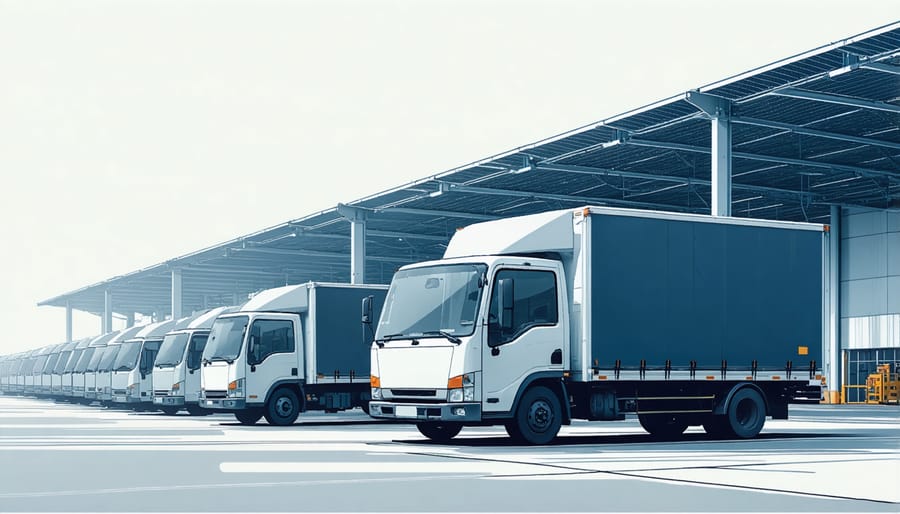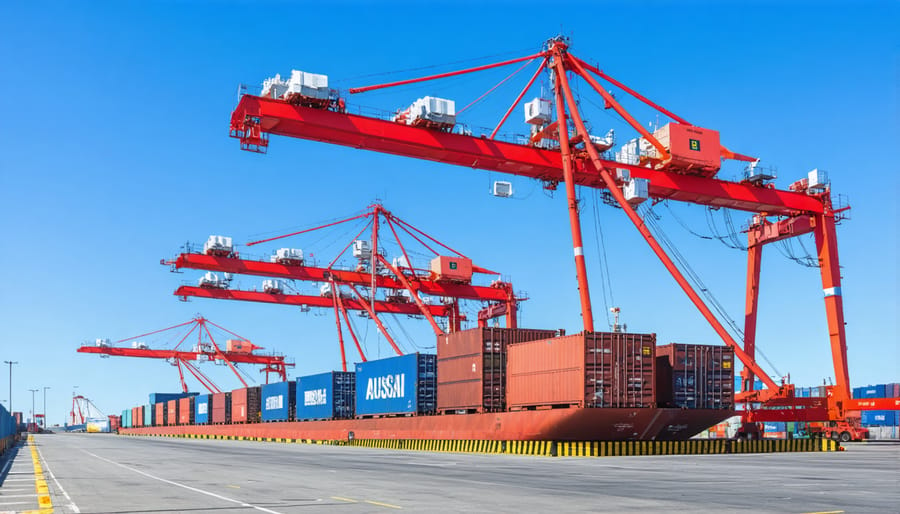In an era where environmental responsibility meets business efficiency, green logistics stands at the forefront of sustainable supply chain evolution. This revolutionary approach transforms traditional logistics operations into environmentally conscious practices, dramatically reducing carbon footprints while enhancing operational efficiency. From electric delivery vehicles navigating city streets to solar-powered warehouses and AI-optimized routing systems, green logistics is reshaping how businesses move goods across Australia and worldwide.
By integrating sustainable practices into every step of the supply chain – from procurement and transportation to storage and last-mile delivery – organizations are not only meeting growing environmental regulations but also capturing significant cost savings and competitive advantages. The surge in consumer demand for eco-friendly products and services has made green logistics more than just an environmental initiative; it’s become a crucial business imperative driving innovation across the logistics sector.
As Australia accelerates its transition toward a more sustainable future, green logistics emerges as a vital solution, offering practical pathways to reduce emissions while maintaining the efficiency and reliability that modern supply chains demand. This transformation represents a fundamental shift in how we think about and manage logistics operations, promising a greener, more sustainable future for generations to come.

What Makes Logistics ‘Green’?
Sustainable Transportation Solutions
Modern green logistics heavily relies on innovative transportation solutions that minimize environmental impact while maintaining operational efficiency. Companies are increasingly adopting electric vehicles (EVs) for last-mile deliveries and hybrid trucks for longer hauls, significantly reducing carbon emissions. In Australia, major logistics providers are leading the charge with impressive biofuel applications in their fleets, demonstrating that sustainable transport isn’t just good for the planet – it’s good for business too.
Rail transport is making a comeback as a greener alternative to road freight, with studies showing it produces up to 75% fewer emissions per tonne-kilometre. Smart route optimization using AI technology helps reduce empty runs and consolidate shipments, while aerodynamic vehicle modifications and low-rolling-resistance tyres improve fuel efficiency.
Many Australian companies are also exploring innovative solutions like cargo bikes for urban deliveries and solar-powered warehouses with EV charging stations. These initiatives, combined with the growing adoption of renewable fuels and hybrid technologies, are transforming the logistics landscape into a more sustainable model for the future.
Warehouse Energy Efficiency
Modern warehouses are evolving into sustainable powerhouses through innovative energy-efficient practices and smart renewable energy integration. Leading Australian facilities are showcasing how strategic design and technology can dramatically reduce environmental impact while cutting operational costs.
Smart lighting systems with motion sensors and LED technology are becoming standard practice, automatically adjusting illumination based on activity levels and natural light availability. Temperature-controlled warehouses are implementing advanced insulation materials and energy-efficient HVAC systems, while solar panels on vast warehouse rooftops are turning these spaces into clean energy generators.
Many facilities are adopting automated energy management systems that optimize power usage during peak and off-peak periods. Smart conveyor systems operate on demand rather than continuously, and electric forklifts powered by renewable energy are replacing traditional fuel-powered vehicles.
Real-world success stories include Melbourne’s eco-warehouse hub, which reduced energy consumption by 40% through solar installation and smart building management systems. These innovations demonstrate that sustainable warehouse operations aren’t just good for the planet – they’re good for business too.
Environmental Benefits of Green Logistics
Carbon Footprint Reduction
Green logistics practices play a crucial role in reducing carbon emissions across the supply chain, offering both environmental benefits and operational cost savings. Companies implementing green logistics strategies have demonstrated significant reductions in their carbon footprint through various innovative approaches.
One of the most effective methods is the optimization of transportation routes. By using advanced software and AI-driven solutions, businesses can plan the most fuel-efficient delivery paths, reducing unnecessary mileage and associated emissions. For instance, major Australian logistics companies have reported up to 30% reduction in fuel consumption through smart route planning.
The adoption of electric and hybrid vehicles in delivery fleets represents another significant step forward. Many Australian businesses are transitioning their fleets to electric alternatives, particularly for last-mile deliveries in urban areas. These vehicles not only eliminate direct emissions but also reduce noise pollution in residential areas.
Warehouse operations are being transformed through energy-efficient lighting, solar power installation, and automated systems that minimize energy waste. Smart building management systems can reduce energy consumption by up to 40% compared to traditional warehouses.
Companies are also embracing consolidated shipments and reverse logistics to minimize empty runs. By combining multiple deliveries and establishing efficient return processes, businesses can significantly reduce the number of vehicles on the road. This approach has shown to cut emissions by up to 25% while improving operational efficiency.
The implementation of these practices often requires initial investment but typically delivers substantial long-term benefits, both environmentally and economically.

Resource Conservation
Resource conservation lies at the heart of green logistics, focusing on smart strategies that maximise efficiency while minimising waste. Australian businesses are increasingly adopting innovative approaches to resource management, from implementing paperless systems to optimising packaging designs that use fewer materials.
A key aspect of resource conservation in logistics is the adoption of reusable packaging solutions. Companies are switching from single-use containers to durable, multi-trip packaging systems that can withstand numerous supply chain cycles. For instance, several Australian supermarket chains have introduced reusable plastic crates for produce transportation, significantly reducing cardboard waste.
Water conservation plays a crucial role too. Modern warehouses are incorporating rainwater harvesting systems and water-efficient cleaning methods. Some facilities have implemented sensor-based irrigation systems for their grounds maintenance, reducing water consumption by up to 50%.
Energy efficiency measures are equally important. Smart lighting systems, energy-efficient cooling solutions, and solar-powered warehouse operations are becoming standard practice. Companies are also optimising their storage spaces through vertical racking systems, effectively reducing their facility footprint and energy requirements.
Waste reduction strategies focus on the ‘3Rs’ principle – Reduce, Reuse, Recycle. This includes implementing reverse logistics systems to handle returns and recycling, establishing partnerships with recycling facilities, and training staff in proper waste segregation practices. Many Australian logistics providers now achieve impressive waste diversion rates, with some facilities approaching zero-waste operations.
Implementing Green Logistics in Australia

Success Stories
Several Australian companies have emerged as pioneers in green logistics, demonstrating that environmental responsibility and business success can go hand in hand. Woolworths Group, one of Australia’s largest retailers, has transformed its supply chain operations by introducing electric delivery vehicles and implementing smart routing systems that have reduced their carbon emissions by 24% since 2015. Their Melbourne distribution centre now operates entirely on renewable energy, setting a new standard for sustainable warehouse operations.
Linfox, a leading logistics provider, has achieved remarkable results through their GreenFox program. By upgrading their fleet to more fuel-efficient vehicles and implementing driver training programs focused on eco-friendly practices, they’ve cut fuel consumption by 45% per kilometre travelled. Their investment in solar-powered warehouses and rainwater harvesting systems has significantly reduced their environmental footprint while saving operational costs.
Australia Post has revolutionised last-mile delivery with their electric bicycle fleet and hybrid vehicles. Their innovative approach includes using recycled materials for packaging and implementing a reverse logistics system that has diverted over 100,000 tonnes of waste from landfills. The organisation has reported a 25% reduction in their carbon emissions per parcel delivered.
TOLL Group’s success story focuses on their multimodal transport strategy. By optimising their mix of rail, road, and sea transport, they’ve reduced their carbon emissions by 30% while maintaining delivery efficiency. Their investment in route optimisation software has decreased empty running trips by 40%, proving that environmental initiatives can drive operational improvements.
These success stories demonstrate that green logistics isn’t just about environmental protection – it’s a pathway to improved efficiency, reduced costs, and enhanced brand reputation. The companies’ achievements have inspired others in the industry to follow suit, creating a ripple effect of sustainable practices across Australia’s logistics sector.
Getting Started
Embarking on a green logistics journey doesn’t have to be overwhelming. Start by conducting a thorough assessment of your current logistics operations, identifying areas where environmental impact can be reduced. This initial audit should focus on transportation routes, warehouse energy consumption, packaging materials, and waste management practices.
Begin with quick wins that offer immediate results. Implement route optimization software to reduce fuel consumption and emissions. Replace traditional packaging with recyclable or biodegradable alternatives, and install energy-efficient lighting in warehouses. These steps not only benefit the environment but also create immediate cost savings.
Training your team is crucial for success. Develop comprehensive education programs that help staff understand the importance of green practices and their role in achieving sustainability goals. Consider appointing “green champions” within different departments to maintain momentum and share best practices.
Sustainable investments in logistics are essential for long-term success. Start small but plan big – allocate resources for electric vehicles, solar panels for warehouses, or automated energy management systems. Many Australian businesses find that government grants and incentives can help offset initial costs.
Set clear, measurable goals with realistic timeframes. For example, aim to reduce carbon emissions by 15% in the first year through improved route planning and vehicle maintenance. Track progress using sustainability metrics and celebrate achievements to maintain team motivation.
Partner with like-minded suppliers and carriers who share your environmental values. Look for certifications like ISO 14001 or SmartWay partnerships. Creating a network of environmentally conscious partners strengthens your green initiatives and helps build a more sustainable supply chain.
Remember, going green is a journey, not a destination. Start with these foundational steps and gradually expand your initiatives as you build momentum and expertise. The key is to begin now and remain committed to continuous improvement.
The Future of Green Logistics
The future of green logistics is rapidly evolving, driven by technological innovation and growing environmental awareness. As Australian businesses increasingly embrace circular economy principles, we’re witnessing transformative changes in how goods are moved, stored, and delivered.
Electric and hydrogen-powered vehicles are set to revolutionise transport logistics, with major Australian transport companies already transitioning their fleets to zero-emission alternatives. Smart warehousing systems, powered by artificial intelligence and IoT sensors, are optimising storage space and reducing energy consumption while maintaining perfect inventory control.
Drone delivery services are no longer just a pipe dream, with trials already underway in several Australian cities. These autonomous delivery systems promise to reduce last-mile delivery emissions and traffic congestion in urban areas. Meanwhile, blockchain technology is enabling unprecedented supply chain transparency, allowing companies to track their environmental impact in real-time and make data-driven sustainability decisions.
3D printing technology is emerging as a game-changer, enabling localised production that significantly reduces transport requirements. This ‘print-on-demand’ approach could dramatically decrease the carbon footprint of manufacturing and distribution networks.
Advanced analytics and machine learning are helping companies optimise delivery routes, reducing fuel consumption and emissions. These systems can predict traffic patterns, weather conditions, and delivery windows with remarkable accuracy, ensuring the most efficient use of resources.
Perhaps most exciting is the development of sustainable packaging solutions. Biodegradable materials and innovative designs are reducing waste while maintaining product protection. Some Australian companies are pioneering reusable packaging systems that can be tracked and returned, creating a closed-loop system that minimises environmental impact.
The future will likely see these technologies working in harmony, creating integrated green logistics networks that are both environmentally responsible and economically viable. As these solutions become more accessible and cost-effective, we can expect to see widespread adoption across the logistics sector, transforming how we think about sustainable supply chain management.
Green logistics represents more than just an environmental trend – it’s a fundamental shift in how businesses approach their supply chain operations. Throughout this article, we’ve explored how sustainable logistics practices can significantly reduce environmental impact while delivering tangible business benefits.
The journey toward greener logistics doesn’t happen overnight, but the rewards are substantial. From reduced operational costs and improved brand reputation to enhanced regulatory compliance and decreased carbon footprint, the advantages of implementing sustainable practices are clear and compelling.
Australian businesses are uniquely positioned to lead the way in green logistics innovation. Our vast landscapes and growing renewable energy sector provide countless opportunities for sustainable transportation solutions and eco-friendly warehouse operations. Companies that have already embraced green logistics are reporting impressive results, with some achieving up to 30% reduction in their carbon emissions while maintaining or improving operational efficiency.
The time to act is now. Whether you’re a small local business or a large corporation, there are practical steps you can take today to begin your green logistics journey. Start by assessing your current operations, setting realistic sustainability goals, and implementing changes gradually. Consider partnering with sustainability experts and investing in green technologies that align with your business objectives.
Remember, green logistics isn’t just about environmental responsibility – it’s about future-proofing your business for a world where sustainability isn’t optional but essential. By embracing these practices today, you’re not only contributing to a healthier planet but also positioning your organization for long-term success in an increasingly environmentally conscious marketplace.

